Chapter: English essay writing topics, sample examples for school, college students and Competitions
Travel : Solola

Solol�
The
market at Solol was a walking museum of fancy dress. Unlike the Indians of
Mexico, who have mostly gone into white cotton pajamas, with a blanket slung
over the shoulder in lieu of great-coat, the Guatemaltecos of the highlands
have kept their old costumes. This conservatism has been to some extent
affected by the slump and the persuasive salesmanship of shopkeepers and
commercial travelers. Nobody starves in this self-supporting agricultural
community; but money is a great deal scarcer than it was a few years ago, when
the coffee fincas were in full production and called, during the picking
season, for whole armies of workers from the hills. Those were the glorious
times when a man could earn as much as twenty-five or thirty cents a day. The
Quich villages were rich: their fiestas were grand events and the more
elaborate of their old dances were staged on a lavish scale; aguardiente flowed
like water, and when a man needed a new suit of the traditional clothes he
could afford to buy the hand-woven cloth, the richly patterned sashes and
kerchiefs, the hat bands and tassels. Today he has to think twice and three
times before he renews his wardrobe. A new outfit will cost him the equivalent
of four or five pounds, and at the present moment this is, for a Quich Indian, an enormous sum. At the local store the price of a
suit of blue dungarees is only a few shillings, and when it is worn out, which
it will be very soon, he will be able to afford to buy another. It looks, I am
afraid, as though the traditional dress of the Indians were doomed. All the
forces of industrialism are arrayed against it. Conservative prejudice cannot
long resist the assaults of economics.
Meanwhile
a majority of highlanders still wear the old costumes - a different one in
every village. The most curious feature, for example, of the Solol costume is
the black varnished hat, which is a strangely flattened version of John Bull's
topper. From another village (I never discovered which; but it cannot have been
far from Solol, for I saw several of its representatives at the market) came
men in large mushroom-shaped hats, exactly like those worn by very
distinguished old English ladies when they go gardening. I had a slight shock
each time I saw one of them. It was as though Miss Jekyll had suddenly gone mad
and taken to staining her face with walnut juice and wearing, with her old hat,
a gray monkey-jacket and white cotton pants.
The
most remarkable thing about these Indian costumes is that they are not Indian
at all, but old European. Little scraps of seventeenth- and eighteenth-century
Spain have been caught here and miraculously preserved, like flies in the hard
amber of primitive conservatism. The Chichicastenango Indians, for example,
wear a short-waisted embroidered jacket and knee-breeches of brown cloth, a gay
woven sash and an embroidered kerchief tied round the head. It is, almost
without modification, the costume of Sancho Panza. Elsewhere one finds a number
of small variations on the Spanish theme. Thus, long kilts will sometimes be
worn below a neatly tailored bullfighter's jacket - a reminiscence, perhaps, of
the loin-cloths of an earlier dispensation.
The
women's dress has been much less profoundly affected by Spanish fashion than
the men's. There is no sign here of the long trailing skirts and
Lancashire-lassie shawls of the Mexicans. The Filipino lady's low-cut corsage
and puffed sleeves, her white petticoat and coquettishly looped-up skirt are
unheard of. True, the Quich women's embroidered bodices may have borrowed something
from European peasant costume; but their short skirts, reaching in many cases
only to the knee - these are unquestionably Indian. Perhaps their color has
changed since the conquest; for they are now dyed with indigo which was
introduced by the Spaniards. But the cut is surely the same as it was when
Alvarado passed this way.
Related Topics